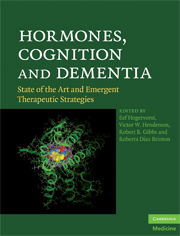Book contents
- Hormones, Cognition and Dementia
- Hormones, Cognition and Dementia
- Copyright page
- Contents
- Contributors
- Preface
- Section 1 Estrogens and cognition: perspectives and opportunities in the wake of the Women's Health Initiative Memory Study
- Section 2 Varieties of estrogenic therapy
- Chapter 7 Alternative estrogenic treatment regimens and the Kronos Early Estrogen Prevention Study – Cognitive and Affective substudy (KEEPS-CA)
- Chapter 8 The use of transdermal 17β-estradiol in the treatment of Alzheimer's disease
- Chapter 9 Alternative modes of treatment: pulsatile estradiol treatment
- Chapter 10 In search of estrogen alternatives for the brain
- Section 3 Potential modulators and modifiers of estrogenic effects
- Section 4 Possible genetic factors related to hormone treatment effects
- Section 5 Testosterone, estradiol and men, and sex hormone binding globulin
- Section 6 Gonadotropin effects
- Index
- Plate Section
Chapter 9 - Alternative modes of treatment: pulsatile estradiol treatment
from Section 2 - Varieties of estrogenic therapy
Published online by Cambridge University Press: 06 July 2010
- Hormones, Cognition and Dementia
- Hormones, Cognition and Dementia
- Copyright page
- Contents
- Contributors
- Preface
- Section 1 Estrogens and cognition: perspectives and opportunities in the wake of the Women's Health Initiative Memory Study
- Section 2 Varieties of estrogenic therapy
- Chapter 7 Alternative estrogenic treatment regimens and the Kronos Early Estrogen Prevention Study – Cognitive and Affective substudy (KEEPS-CA)
- Chapter 8 The use of transdermal 17β-estradiol in the treatment of Alzheimer's disease
- Chapter 9 Alternative modes of treatment: pulsatile estradiol treatment
- Chapter 10 In search of estrogen alternatives for the brain
- Section 3 Potential modulators and modifiers of estrogenic effects
- Section 4 Possible genetic factors related to hormone treatment effects
- Section 5 Testosterone, estradiol and men, and sex hormone binding globulin
- Section 6 Gonadotropin effects
- Index
- Plate Section
Summary
It is increasingly clear that not all estrogenic treatment regimens are alike with respect to effects on the brain, and that alternative regimens need to be evaluated and compared. In this chapter, Li and Al-Azzawi discuss the advantages of intranasal pulsatile estradiol administration relative to oral or transdermal therapies. Pharmacokinetic analyses demonstrate the feasibility of using intranasal pulsatile estradiol treatments to produce estradiol exposures comparable to those achieved via a transdermal route. As with transdermal therapies, intranasal application avoids the negative effects on liver enzymes associated with oral treatment. Major differences in the effects of pulsatile vs. sustained estradiol administration on gene expression have been detected. In addition, there are noted potential advantages of pulsatile vs. sustained treatment such as up-regulation of estrogen receptors, initialization of estrogen receptor co-factors, repeated activation of non-genomic pathways, and lower levels of potentially active (and carcinogenic) metabolites.
- Type
- Chapter
- Information
- Hormones, Cognition and DementiaState of the Art and Emergent Therapeutic Strategies, pp. 87 - 92Publisher: Cambridge University PressPrint publication year: 2009



